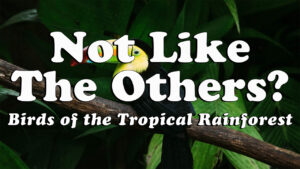
Not Like The Others: Ants of the World!
Students will determine which type of ant is not like the others.

Not Like The Others: Rainforests
Which of these rainforests is not like the others?

Not Like The Others: Cephalopods
Students will determine which cephalopod is not like the others.

Not Like The Others: Deserts
Which of these deserts is not like the others?

Concept Attainment: Hornet vs Tiger
Can your class spot the vertebrates vs invertebrates?

Concept Attainment: Walnut vs Clouds
Let’s look at living vs non-living things.

Notice, Wonder: An Orange Thing
A mysterious image. Reveal it slowly. Let your students wonder!

What’s In My Brain: Coral vs Water Lilies
Let’s look at saltwater vs freshwater organisms.

The Tournament of Biomes
Want to move beyond memorizing the characteristics of biomes? In this lesson, students work through a Tournament of Biomes, explaining which biome wins in each round (based on criteria you choose). In the end, they crown a 👑 Champion Biome!

Notice, Wonder: Krzywy Las
A mysterious image. Reveal it slowly. Let your students wonder!

What’s In My Brain: Tree vs Tree
Let’s look at deciduous vs coniferous trees.

Plant Adaptation Tournament
Who will win in a tournament of eight plants with Interesting adaptations!?

Not Like The Others: Snakes of the Rainforest
Students will determine which snake of the rainforest is not like the others.

Not Like The Others: Birds of the Desert
Students will determine which desert bird is not like the others.

Create A Creature
Create a new creature based on the adaptations of existing creatures from the same biome.

Animal Adaptation Tournament
Which animal has the most interesting, most valuable, or strangest adaptations?

Notice, Wonder: Bloom
A mysterious image. Reveal it slowly. Let your students wonder!

What’s In My Brain: Owl vs Eagle
Some of these animals are nocturnal and some are diurnal.

Not Like The Others: Birds of the Tropical Rainforest
Which of these four birds is not like the others?

Not Like The Others: Creatures of the Tundra
Students will determine which creature of the tundra is not like the others.

Creating A Realistic Flower and Pollinator
Your students will create a new flower, designed to attract a specific pollinator.

Notice, Wonder: Critter
A mysterious image. Reveal it slowly. Let your students wonder!

The Pros and Cons of Producers and Consumers
Sure, students might know the difference between a producer and a consumer… but have they considered how they feel about each other? What, in a producer’s opinion, are the pros and cons of a consumer?

Not Like The Others: Penguins
Students will determine which type of penguin is not like the others.

Two Animals Switch Biomes
What if a capybara and a kangaroo rat switched homes? Would their adaptations be helpful at all?

Notice, Wonder: Silver Torch
A mysterious image. Reveal it slowly. Let your students wonder!

Not Like The Others: Flowers
Students will determine which flower is not like the others.